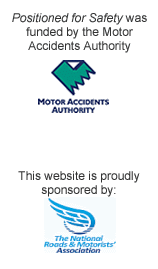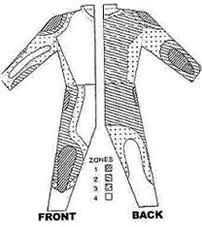Motorcycle Protective Clothing
A full set of motorcycle gear can easily set you back between $1,500 and $4,000 by the time you have bought a helmet, jacket, gloves, pants and boots. What are you paying for?
- Protection from injury?
- Protection from the weather?
- Protection from other motorists?
- A fashion statement?
The Motor Accidents Authority of NSW (MAA) provided a research grant to the MCC to investigate motorcycle protective clothing. The objective was to write a guide on how to choose clothing that will help to keep you safer.
We looked at research into motorcycle crashes, injury rates and protective clothing. A report on the findings was presented at the 2003 Road Safety Research, Policing and Education Conference
- Good protective gear can prevent or reduce some types of injury in a crash.
- Well designed motorcycle gear will make you safer and more alert by reducing discomfort, fatigue and dehydration.
- Bright colours and contrasts may make you more visible and draw the attention of other motorists.
- European Standards set minimum levels for the construction and test performance of all motorcycle gear that claims to provide protection from injury. There are no similar standards for motorcycle clothing from the USA.
- Independent tests in the UK suggest that much of the motorcycle gear in the market will not provide adequate levels of injury protection. See Jackets and pants
How can you tell the difference between gear that will provide protection and what just looks good?
The best way to be sure you are buying gear that is protective is to choose products that have been tested against recognised standards.
- Look for product tests in motorcycle magazines. One UK magazine RiDE regularly compares products using the tests required under the European standards. This means they are tested to see how they will perform in a crash. The results are often disturbing as products from many well known brands have failed these tests. The good news is that the most expensive products are not necessarily the best in terms of injury protection.
- If a product has not been tested, it is not possible to know how well it will perform in a crash. However there are some design and construction features that will help you to recognise gear that is more likely to do the job (see below).
- Look for a CE label indicating that the item complies with the relevant European Standard for Motorcycle Protective clothing. Only a limited range of CE labelled gear (with the exception of impact protectors) is currently available in Australia. Note: Jackets with impact protectors will often have CE labels (EN 1621-1 or EN 1621-2). These labels only refer to the impact protectors, they do not include the jacket itself, which must be labelled EN 13595 if it complies.
See Frequently Asked Questions
European Standards
By law in Europe, motorcycle gear can only be designated “protective” if it is capable of providing protection from injury. Weather gear cannot be designated “protective”. There are European Standards that set minimum levels for the construction and test performance of motorcycle jackets, trousers, suits, impact protectors, boots and gloves. The tests examine abrasion, tear, burst and impact resistance.
Motorcycle protective gear made for the European market should be marked with a CE label which states that it has been tested and complies with the relevant European Standard. See European Standards for the relevant CE label number for each type of gear.
- Protection from injury What parts of your body do you need to protect? Studies of injury patterns from motorcycle crashes around the world show a consistent pattern in the types of injuries suffered.
- Protection from the weather Motorcycle clothing may also help to prevent crashes by keeping you comfortable and alert under all sorts of riding conditions.
- Protection from SMIDSY crashes (‘Sorry Mate I Didn’t See You) What can you do to improve your chances of being noticed by other motorists?
- Helmets Choosing and caring for your helmet.
- Jackets and pants What to look for in buying motorcycle jackets or pants.
- Boots What to look for when buying motorcycle boots.
- Gloves What to look for when buying motorcycle gloves.
- Impact protectors Do impact protectors really work?
- What do Australian motorcyclists wear? A report on a survey of riders and pillions.
- References A list of the research references we have used in compiling this site.
- European Standards for Motorcycle Personal Protective Equipment.


